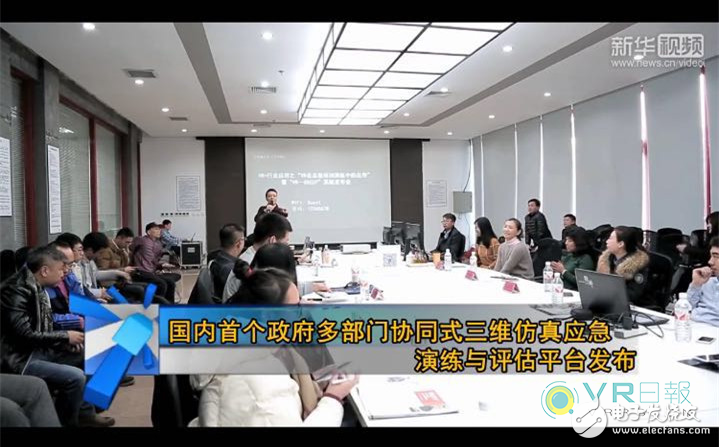On November 23, the 14th phase of the wormhole VR salon was held as scheduled. Looking back on this year, from the very beginning of VR+ real estate, VR+ education, VR+tourism, VR+film and many other fields, wormhole VR salon has been involved. At the last special salon at the end of 2016, VR wormhole and Beijing Oriental Nuclear Power Co., Ltd. jointly released the VR upgrade version of the “Government Multi-Department Synergy 3D Simulation Emergency Training and Evaluation Platformâ€.
The launch of this new product was accompanied by a discussion of the combination of emergency drills and VR, which deepened the understanding of the field of virtual reality technology to protect public safety. Everyone reached a consensus: VR will promote the government's emergency response capabilities and benefit the people at a deeper level.
On-site release: SSEEP system VR version is coming

SSEEP is China's first multi-sector interactive exercise and evaluation system for the Chinese government. The team led by Dr. Zhang Wei, chairman of the Zhongguancun Emergency Industry Alliance, developed in June 2016. This scenario-based government multi-sector 3D simulation emergency training The exercise platform adopts the distributed + cloud platform deployment in an innovative way. It can utilize the government's existing emergency platform site and network environment to meet both individual drills and comprehensive drills; achieve cross-regional joint drills and break through the drill site. And restrictions on the number of drills. The platform provides standard interface services, and the interface is flexible and easy to expand, and can interface with the structural, unstructured, and semi-structured data of the existing emergency preparedness of the government department.
Recently, the product designer Dr. Zhang Wei and VR wormhole upgraded SSEEP to VR drill version, which is also the first “VR simulation emergency drill and evaluation platform†in China. In the VR version of the SSEEP, the drill scene is set in the disaster scene of the VR panorama. The role of the drill can be used for voice or operation interaction in the VR. They replace the traditional keyboard and mouse with the handle, and the VR helmet can See the restoration of the disaster panorama. In the key tasks of disaster management, students can choose countermeasures or coordinate multi-department linkage through the handles, and can roam freely in various scenarios of disasters to complete related tasks and better increase the immersive experience of the drills.
At present, the SSEEP system has begun to provide services for the government's emergency department in Beijing, and won the “Best Innovation Product Award†in the 2016 China Emergency Industry Informatization. The SSEEP system is currently shortlisted for the National 13th Five-Year Plan.
Guest interview
Wang Lin
Wormhole VR Chairman

Reporter (hereinafter referred to as the record): VR wormhole is a platform-type VR company. Why is it involved in the emergency rehearsal field?
Wang Lin (hereafter referred to as Wang): Many people think that VR is a icing on the cake, not a non-use, but in the field of safety education, VR+ emergency drills can be said to be in the snow. Because the traditional emergency plan drill has three major drawbacks: First, the safety is uncontrollable, the fire drill has become a fire, it has not happened; the second is that it consumes a lot of manpower and material resources; the third is that the number of participants is small and the effect is not satisfactory. Although the platform is expensive to invest in the initial stage, it can be used indefinitely in the future, and the use of virtual reality technology can greatly reduce the cost and risk of actual drills, satisfy the immersive experience of the practitioners, and facilitate learning. The effect of the drill is unquestionable.
Reporter: How do you see the prospects for VR+ emergency?
Wang: At present, the domestic industry has not applied VR technology to this large scale, but it has already been applied abroad. At the 5th anniversary of the March 11th tsunami, Japan used Oculus for disaster prevention simulation in Aichi Prefecture. The New York Emergency Management Office in the United States uses advanced disaster management simulators for training. The Los Angeles Police Department uses a simulation system to improve the commander's ability to deal with disasters. The project was prepared by the University of Southern Mississippi to provide solutions for the evacuation of stadiums with a capacity of tens of viewers. All in all, the application capabilities of VR technology in disaster prevention and disaster relief training are far higher than traditional training forms, and are gaining more and more recognition internationally.
Reporter: What are the plans for the cooperation between the two parties in the next step?
Wang: In the future, we will introduce an enhanced version of the government VR exercise version in the technology. We will use the pupil recognition technology to make the drills more convenient to complete the various exam questions in the drill. Through the voice command, the drill personnel can work in the drill. Other students will upload and exchange information, and even discuss the operational plan of the emergency command. The SSEEP scenario-based government multi-sector VR simulation emergency drill and evaluation platform system is applicable not only to the government, but also to schools (universities, primary and secondary schools) and the public. Similar mature cases of VR commercial applications like this have not yet appeared in the international arena.
Based on VR wormhole exploration of VR+ education, VR wormhole will cooperate with Beijing Oriental Nuclear Power Co., Ltd. to develop a series of natural disasters such as earthquake, flood, hurricane, fire and campus violence for teachers and students. Or man-made disaster VR drill courseware. The planning of VR wormhole and Oriental core force in 2017 is: find a 300 square meter venue for 100 or even more than 1,000 people. The equipment can use VR helmet or VR machine to realize human interaction in the same scene. The scene can also be changed according to the theme of the exercise.
We will also introduce VR eye recognition technology for the interaction and answering of the exercises, allowing the exercisers to abandon the handles and release their hands to operate some auxiliary physical props that are helpful to the plot, to enhance the immersion experience and increase more. The interactive scenario gives the director more room to play.
Zhang Wei
Chief Financial Officer of the International Emergency Management Association and Vice Chairman of the China Committee

Reporter (hereinafter referred to as the record): What is the design basis of this product?
Zhang Wei (hereinafter referred to as Zhang): The preparation of the emergency drill process draws on the technical system of the HSEEP Exercise Evaluation Plan of the US Department of Homeland Security and the US NPG National Emergency Preparedness Objective, and is based on the State Council Emergency Office Letter No. 62 of 2009. The Emergency Response Guide for the Incident and the "Emergency Response Law of the People's Republic of China" and related special plans, department plans, and local plan completion plan design.
Reporter: What are the main features of the product?
Zhang: There are six characteristics of the product. One is the “immersive experienceâ€, which is the immersive experience in emergency drills through three-dimensional simulation, video insertion and voice response. It is at the leading level in China; Through the government's private network cloud platform, the government's multi-sectoral off-site drills are implemented, which is in line with the reality of China's multi-sector emergency response; the third is the combination of "virtual and virtual", that is, real data + virtual events, we passed with the Institute of Remote Sensing of the Chinese Academy of Sciences, etc. Unit cooperation, dynamic collection of urban real-world data, 3D modeling and emergency drills of “real data + virtual eventsâ€, targeted, and directly improve the emergency response capabilities and coordination capabilities of relevant departments after the drill; Fourth, “start and end†Through the emergency capability list, the assessment after the emergency drill is realized, and a series of reports are given through intelligent analysis. The fifth is “flexible formâ€. Through the flexible task setting of the timeline, the platform can adjust the contents of the drills and assessments for different drills. Achieve flexible customization and upgrade of the course; sixth is “independent†through “experts The classic repository and the dynamic score table enable self-learning, self-improvement and self-optimization of the platform.
Reporter: Can you give an example of a specific plan design?
Zhang: For example, we have a courseware for comprehensive emergencies such as horror, fire, and trampling, which lasts for twenty minutes. The background of the emergency is: a college is rehearsing for the celebration activities. After the school receives a threatening phone call from explosives in the stadium, the rehearsal scene in the stadium exploded and the students in the rehearsal stage collapsed and stepped on when they fled. In the series of serial disasters, the units involved in the series of disasters include: the Municipal Emergency Office, the Municipal Anti-Terrorism and Criminal Case Emergency Command, the on-site command, the Municipal Public Security Bureau, and the Municipal Public Security Fire. Bureau, city red cross, 999 emergency rescue center, 999 medical rescue team, school office, school security department, school hospital and other departmental roles. The course has a total of nine important stages, from “incident and reception†to the final “post-disposal, investigation and summaryâ€. The total scores of the main and objective questions can be systematically reviewed, rich and diverse questions and various types of system information pushes from beginning to end, etc., to improve the students' emergency response capabilities.
Yan Yue
Oriental Core Product Manager and Art Director

Reporter (hereinafter referred to as the note): Please tell us how to upgrade 3D SSEEP to VR version SSEEP?
Yan Yue (hereinafter referred to as Yan): The technical composition of the 3D simulation exercise is divided into four major frameworks: one is the construction of the three-dimensional scene and the production of the three-dimensional model; the second is the UI interface operation, the answer can be realized and interacted; the third is the underlying architecture. Editor, we choose Unity3D engine, which is convenient for 3D SSEEP to upgrade directly to VR version SSEEP. It can be said that this editor is convenient and efficient. The fourth is the data management in the background, collecting the drill data of the drillers, giving a score report, and also being used for self-learning, which is very practical.
Reporter: What advice do you have for implementing a multiplayer collaborative exercise in the same scene?
Yan: Since each walkthrough role needs to write a timeline script, especially when referring to the HSEEP multiplayer drill, we found that we need to write more timeline scripts. This is a hard and arduous task that needs to be high. Level emergency experts guide the script design work. I hope that we can realize the VR's hundreds or even thousands of people's exercises as soon as possible. In the VR helmet, we can answer and interact with the eyeballs, and liberate the hands of the trainers to better complete more plots. As a VR director, this will give me more imagination and space to play.
Japanese Lamp,Japanese LED Bedroom Lamp,Japanese LED Light,LED Lighting Japanese Standard
Dongguan baiyou electronic co.,ltd , https://www.dgbaiyou.com